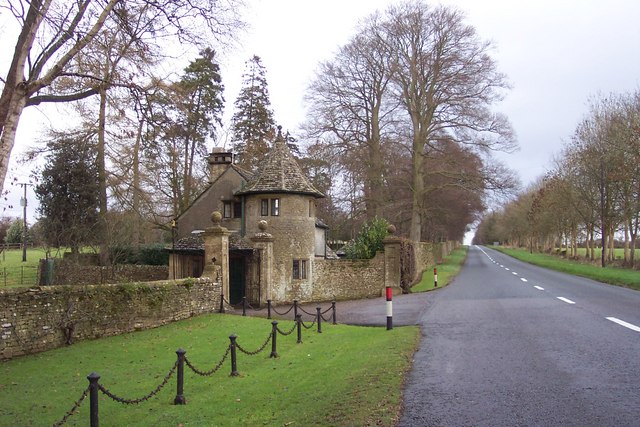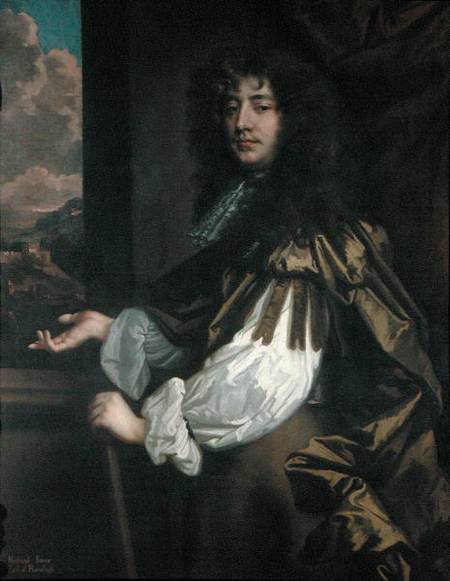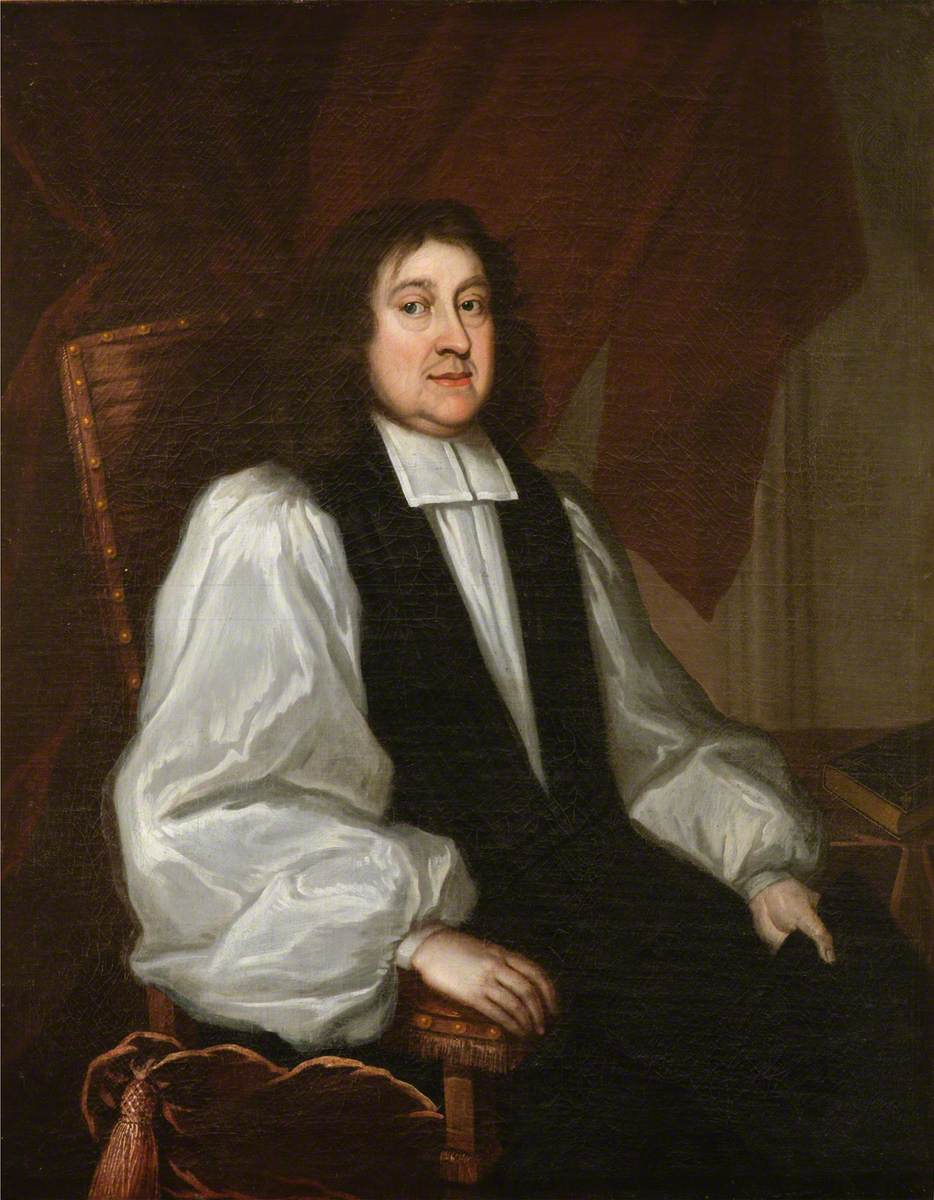|
John Grobham Howe (1657–1722)
John Grubham Howe (1657–1722), commonly known as Jack Howe, was an English politician. Elected on numerous occasions as Member of Parliament, he made the transition from the Whig to the Tory faction. Early life He was second son of John Grobham Howe of Langar, Nottinghamshire, who was member of parliament for Gloucestershire. His mother was Annabella, third and youngest illegitimate daughter and coheiress of Emanuel Scrope, 1st Earl of Sunderland. Early in life he figured as a young and amorous courtier. In 1679 he brought an accusation against Frances Stewart, Duchess of Richmond, which on investigation proved to be false, and he was forbidden to attend the court. At this period he wrote verses. Member of Parliament Following the Glorious Revolution he sat for Cirencester in the Convention parliament, January 1689 to February 1690, and in its two successors 1690–1695 and 1695–1698. The county of Gloucester returned him in 1698, and again in January 1701. At the subseque ... [...More Info...] [...Related Items...] OR: [Wikipedia] [Google] [Baidu] |
English People
The English people are an ethnic group and nation native to England, who speak the English language in England, English language, a West Germanic languages, West Germanic language, and share a common history and culture. The English identity is of History of Anglo-Saxon England, Anglo-Saxon origin, when they were known in Old English as the ('race or tribe of the Angles'). Their ethnonym is derived from the Angles, one of the Germanic peoples who migrated to Great Britain around the 5th century AD. The English largely descend from two main historical population groups the West Germanic tribes (the Angles, Saxons, Jutes and Frisians) who settled in southern Britain following the withdrawal of the Ancient Rome, Romans, and the Romano-British culture, partially Romanised Celtic Britons already living there.Martiniano, R., Caffell, A., Holst, M. et al. Genomic signals of migration and continuity in Britain before the Anglo-Saxons. Nat Commun 7, 10326 (2016). https://doi.org/10 ... [...More Info...] [...Related Items...] OR: [Wikipedia] [Google] [Baidu] |
Thomas Osborne, 1st Duke Of Leeds
Thomas Osborne, 1st Duke of Leeds, (20 February 1632 – 26 July 1712), was a prominent English politician. Under King Charles II (and known at the time as Lord Danby), he was the leading figure in the government for around five years in the mid-1670s. He fell out of favour due to corruption and other scandals, and was impeached and eventually imprisoned in the Tower of London for five years until the accession of James II of England in 1685. In 1688 he was one of the Immortal Seven group that invited William III, Prince of Orange to depose James II as monarch during the Glorious Revolution. He was again the leading figure in government, known at the time as the Marquess of Carmarthen, for a few years in the early 1690s. Early life, 1632–1674 Osborne was the son of Sir Edward Osborne, Baronet of Kiveton, Yorkshire, and his second wife Anne Walmesley, widow of Thomas Middleton; she was a niece of Henry Danvers, 1st Earl of Danby. Thomas Osborne was born in 1632. He wa ... [...More Info...] [...Related Items...] OR: [Wikipedia] [Google] [Baidu] |
Sir Thomas Littleton, 3rd Baronet
Sir Thomas Littleton, 3rd Baronet, often Thomas de Littleton, (3 April 1647 – 31 December 1709), of North Ockendon, Essex and Stoke St. Milborough, Shropshire, was an English lawyer and Whig politician who sat in the English and British House of Commons between 1689 and 1709. He served as Speaker of the House of Commons of England from 1698 to 1700, and as Treasurer of the Navy until his death. Littleton was the son of Sir Thomas Littleton, 2nd Baronet (died 1681), and his wife and cousin Anne Littleton. He was related to Thomas de Littleton, a 15th-century jurist and legal theorist of the Littleton/Lyttelton family. He matriculated at St Edmund Hall, Oxford in 1665 and was admitted at Inner Temple in 1666. In 1671, he was called to the bar. He succeeded his father in the baronetcy on 12 April 1681. On 6 September 1682, he married Anne Baun (died 1714), daughter of Benjamin Baun alias Baron, of Westcote, Gloucestershire. Littleton was returned as Member of Parliament for Woo ... [...More Info...] [...Related Items...] OR: [Wikipedia] [Google] [Baidu] |
John Nichols (printer)
John Nichols (2 February 1745 – 26 November 1826) was an English printer, author and antiquary. He is remembered as an influential editor of the ''Gentleman's Magazine'' for nearly 40 years; author of a monumental county history of Leicestershire; author of two compendia of biographical material relating to his literary contemporaries; and as one of the agents behind the first complete publication of Domesday Book in 1783. Early life and apprenticeship He was born in Islington, London to Edward Nichols and Anne Wilmot. On 22 June 1766 he married Anne, daughter of William Cradock. Anne bore him three children: Anne (1767), Sarah (1769), and William Bowyer (born 1775 and died a year later). His wife Anne also died in 1776. Nichols was married a second time in 1778, to Martha Green who bore him eight children. Nichols was taken for training by "the learned printer", William Bowyer the Younger in early 1757.Keith Maslen, ‘Bowyer, William (1699–1777)’, ''Oxford Dictionary of ... [...More Info...] [...Related Items...] OR: [Wikipedia] [Google] [Baidu] |
Stowell Park
Stowell Park Estate is a historic agricultural and sporting estate in the Cotswold Hills, Gloucestershire, England. The estate includes the village of Yanworth. The main house is a Grade II* listed building and surrounded by extensive parkland, a mill, and church. The landscaped park is listed Grade II on the Register of Historic Parks and Gardens. History The house was built around 1600 for Robert Atkinson, on the site of a previous house. The manor is first recorded in 1086 when it was held by the Archbishop of York. The house is Grade II* listed. The Church of St Leonard was the chapel for the owners of the previous house, having been built in the 12th century. The church has been described as "of very great interest, as it contains quite well-preserved fragments of twelfth-century wall-paintings". The estate was passed to relatives of Atkinson until 1685 when it was bought by John Grubham Howe whose descendants owned the estate until 1811 when it was bought by th ... [...More Info...] [...Related Items...] OR: [Wikipedia] [Google] [Baidu] |
Richard Jones, 1st Earl Of Ranelagh
Richard Jones, 1st Earl of Ranelagh (8 February 1641 – 5 January 1712), known as The Viscount Ranelagh between 1669 and 1677, was an Irish peer, politician both in the Parliaments of England and Ireland. Background He was the eldest son of Arthur Jones, 2nd Viscount Ranelagh and Katherine Boyle, daughter of the Earl of Cork who counted amongst her brothers the chemist Robert Boyle and Lord Broghill, the later Earl of Orrery who was a prominent politician in Cromwellian and Restoration times. Jones's mother was estranged from her husband who appears to have been a drunkard and Richard Jones was largely brought up in his mother's household in London. Irish parliamentary career Following the Restoration of Charles II he became a member of the Irish Parliament for Roscommon, and in 1668 was appointed to the Privy Council of Ireland. In the Irish parliament, Ranelagh was associated initially with the group which opposed the land settlement being proposed by Ormond, the then vice ... [...More Info...] [...Related Items...] OR: [Wikipedia] [Google] [Baidu] |
Vice-Admiral Of Gloucestershire
The Vice-Admiral of Gloucestershire was responsible for the defence of the county of Gloucestershire, England. History As a vice-admiral, the post holder was the chief of naval administration for his district. His responsibilities included pressing men for naval service, deciding the lawfulness of prizes (captured by privateers), dealing with salvage claims for wrecks and acting as a judge. The earliest record of an appointment was of Edmund Brydges, 2nd Baron Chandos 1559–1573. In 1863 the Registrar of the Admiralty Court stated that the offices had 'for many years been purely honorary' (HCA 50/24 pp. 235–6). Appointments were made by the Lord High Admiral when this officer existed. When the admiralty was in commission appointments were made by the crown by letters patent under the seal of the admiralty court. Vice-admirals of Gloucestershire This is a list of people who have served as Vice-Admiral of Gloucestershire. * Edmund Brydges, 2nd Baron Chandos 155 ... [...More Info...] [...Related Items...] OR: [Wikipedia] [Google] [Baidu] |
Prince George Of Denmark
Prince George of Denmark ( da, Jørgen; 2 April 165328 October 1708) was the husband of Anne, Queen of Great Britain. He was the consort of the British monarch from Anne's accession on 8 March 1702 until his death in 1708. The marriage of George and Anne was arranged in the early 1680s with a view to developing an Anglo-Danish alliance to contain Dutch maritime power. As a result, George was unpopular with his Dutch brother-in-law, William III, Prince of Orange, who was married to Anne's elder sister, Mary. Anne and Mary's father, the British ruler James II and VII, was deposed in the Glorious Revolution in 1688, and William and Mary succeeded him as joint monarchs with Anne as heir presumptive. The new monarchs granted George the title of Duke of Cumberland. William excluded George from active military service, and neither George nor Anne wielded any great influence until after the deaths of Mary and then William, at which point Anne became queen. During his wife's reign, Geo ... [...More Info...] [...Related Items...] OR: [Wikipedia] [Google] [Baidu] |
Sir John Fenwick, 3rd Baronet
Sir John Fenwick, 3rd Baronet (c. 1645 – 28 January 1697) was an English Jacobite conspirator, who succeeded to the Baronetcy of Fenwick on the death of his father in 1676. He was involved in a Jacobite plot to assassinate the monarch. He was beheaded in 1697. Life Fenwick was the eldest son of Sir William Fenwick, or Fenwicke, a member of an old Northumberland family. He entered the army, becoming major-general in 1688, but before this date, he had been returned in succession to his father as one of the Members of Parliament for Northumberland, which county he represented from 1677 to 1687. He was a strong partisan of King James II, and in 1685 was one of the principal supporters of the act of attainder against the Duke of Monmouth; but he remained in England when William III ascended the throne in the Revolution of 1688. He had financial problems and in 1688 he sold the rump of the family estates and Wallington Hall to Sir William Blackett for £4000 and an annuity of ... [...More Info...] [...Related Items...] OR: [Wikipedia] [Google] [Baidu] |
War Of The League Of Augsburg
The Nine Years' War (1688–1697), often called the War of the Grand Alliance or the War of the League of Augsburg, was a conflict between Kingdom of France, France and a European coalition which mainly included the Holy Roman Empire (led by the Habsburg monarchy), the Dutch Republic, Kingdom of England, England, Spanish Empire, Spain, Duchy of Savoy, Savoy, Swedish Empire, Sweden and Portuguese Empire, Portugal. Although not the first European war to spill over to Europe's overseas colonies, the events of the war spread to such far away places as the Americas, India, and West Africa. It is for this reason that it is sometimes considered the first world war. The conflict encompassed the Glorious Revolution in England, where William III of England, William of Orange deposed the unpopular James II of England, James VII and II and subsequently struggled against him for control Jacobite rising of 1689, of Scotland Williamite war in Ireland, and Ireland, and King William's War, a cam ... [...More Info...] [...Related Items...] OR: [Wikipedia] [Google] [Baidu] |
Gilbert Burnet
Gilbert Burnet (18 September 1643 – 17 March 1715) was a Scottish philosopher and historian, and Bishop of Salisbury. He was fluent in Dutch, French, Latin, Greek, and Hebrew. Burnet was highly respected as a cleric, a preacher, an academic, a writer and a historian. He was always closely associated with the Whig party, and was one of the few close friends in whom King William III confided. Early life: 1643–1674 Burnet was born at Edinburgh, Scotland, in 1643, the son of Robert Burnet, Lord Crimond, a Royalist and Episcopalian lawyer, who became a judge of the Court of Session, and of his second wife Rachel Johnston, daughter of James Johnston, and sister of Archibald Johnston of Warristoun, a leader of the Covenanters. His father was his first tutor until he began his studies at the University of Aberdeen, where he earned a Master of Arts in Philosophy at the age of thirteen. He studied law briefly before changing to theology. He did not enter into the ministry at that ... [...More Info...] [...Related Items...] OR: [Wikipedia] [Google] [Baidu] |
Whitehall Palace
The Palace of Whitehall (also spelt White Hall) at Westminster was the main residence of the English monarchs from 1530 until 1698, when most of its structures, except notably Inigo Jones's Banqueting House of 1622, were destroyed by fire. Henry VIII moved the royal residence to White Hall after the old royal apartments at the nearby Palace of Westminster were themselves destroyed by fire. Although the Whitehall palace has not survived, the area where it was located is still called Whitehall and has remained a centre of government. White Hall was at one time the largest palace in Europe, with more than 1,500 rooms, overtaking the Vatican, before itself being overtaken by the expanding Palace of Versailles, which was to reach 2,400 rooms. The palace gives its name, Whitehall, to the street located on the site on which many of the current administrative buildings of the present-day British government are situated, and hence metonymically to the central government itself. At its ... [...More Info...] [...Related Items...] OR: [Wikipedia] [Google] [Baidu] |







